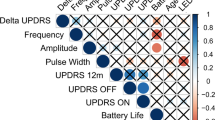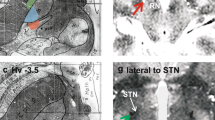Abstract
Subthalamic nucleus (STN) deep brain stimulation (DBS) is the most common surgical treatment for managing motor complications in Parkinson’s disease (PD). Ultimately, outcomes depend on a variety of factors including lead location, access and expertize in programming and PD medical management. Nevertheless, achieving ideal programming settings can be difficult in certain patients, leading to suboptimal control of symptoms and stimulation-induced side effects, notably dysarthria and dyskinesia. Interleaved stimulation (ILS) is a newer programming technique that attempts to optimize the stimulation field, improving control of symptoms while minimizing stimulation-induced adverse effects. A retrospective chart review was performed on PD patients receiving STN DBS over the past 12 months. Clinical and demographic data were collected from patients identified as having received ILS. The rationale and clinical efficacy of ILS was analyzed. Nine patients received ILS due to incomplete PD symptom control or stimulation-induced side effects after attempting multiple programming options. Appropriate lead location was confirmed with postoperative MRI except in one case. Following ILS, patients reported improvement in symptoms and resolution of side effects, while preserving adequate control in Parkinsonism with a mean improvement in UPDRS-MOTOR scores of 51.2 %. ILS continues to emerge as a safe and effective programming strategy for maximizing symptom control in PD while diminishing stimulation-induced side effects.




Similar content being viewed by others

References
Benabid AL, Chabardes S, Mitrofanis J, Pollak P (2009) Deep brain stimulation of the subthalamic nucleus for the treatment of Parkinson’s disease. Lancet Neurol 8:67–81
Starr PA, Christine CW, Theodosopoulos PV, Lindsey N, Byrd D, Mosley A et al (2002) Implantation of deep brain stimulators into the subthalamic nucleus: technical approach and magnetic resonance imaging-verified lead locations. J Neurosurg 97:370–387
Kleiner-Fisman G, Herzog J, Fisman DN, Tamma F, Lyons KE, Pahwa R et al (2006) Subthalamic nucleus deep brain stimulation: summary and meta-analysis of outcomes. Mov Disord 21(Suppl 14):S290–S304
Kuncel AM, Cooper SE, Grill WM (2008) A method to estimate the spatial extent of activation in thalamic deep brain stimulation. Clin Neurophysiol 119:2148–2158
Baumann CR, Imbach LL, Baumann-Vogel H, Uhl M, Sarnthein J, Surucu O (2012) Interleaving deep brain stimulation for a patient with both Parkinson’s disease and essential tremor. Mov Disord 27:1700–1701
Wojtecki L, Vesper J, Schnitzler A (2011) Interleaving programming of subthalamic deep brain stimulation to reduce side effects with good motor outcome in a patient with Parkinson’s disease. Parkinsonism Relat Disord 17:293–294
Kovacs N, Janszky J, Nagy F, Balas I (2012) Changing to interleaving stimulation might improve dystonia in cases not responding to pallidal stimulation. Mov Disord 27:163–165
Barbe MT, Dembek TA, Becker J, Raethjen J, Hartinger M, Meister IG et al (2014) Individualized current-shaping reduces DBS-induced dysarthria in patients with essential tremor. Neurology 82:614–619
Medtronic. Activa® SC, Activa® PC and Activa® RC Online Learning. Interleaving: multiple programs per hemisphere. pp 1–9, 2014
Moffitt MA LD, Bradley K (2009) Real-time programming strategies. Springer Science+Business Media LLC, New York
Acknowledgments
We thank Dr. William Marks and Susan Heath for their suggestions in developing the programming algorithms. Dr. Ramirez-Zamora receives grant support from Boston Scientific and is a consultant for TEVA Neurosciences. Dr. Pilitsis receives grants from NIH, St. Jude, and Boston Scientific and is a consultant for Boston Scientific, St. Jude, and Medtronic.
Conflicts of interest
None.
Ethical standards
All study procedures were approved by the Albany Medical Center ethical standards committee.
Author information
Authors and Affiliations
Corresponding author
Rights and permissions
About this article
Cite this article
Ramirez-Zamora, A., Kahn, M., Campbell, J. et al. Interleaved programming of subthalamic deep brain stimulation to avoid adverse effects and preserve motor benefit in Parkinson’s disease. J Neurol 262, 578–584 (2015). https://doi.org/10.1007/s00415-014-7605-3
Received:
Revised:
Accepted:
Published:
Issue Date:
DOI: https://doi.org/10.1007/s00415-014-7605-3



